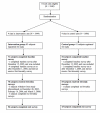Evaluation of influenza prevention in the workplace using a personally controlled health record: randomized controlled trial
- PMID: 18343794
- PMCID: PMC2483848
- DOI: 10.2196/jmir.984
Evaluation of influenza prevention in the workplace using a personally controlled health record: randomized controlled trial
Abstract
Background: Personally controlled health records (PCHRs) are accessible over the Internet and allow individuals to maintain and manage a secure copy of their medical data. These records provide a new opportunity to provide customized health recommendations to individuals based on their record content. Health promotion programs using PCHRs can potentially be used in a variety of settings and target a large range of health issues.
Objectives: The aim was to assess the value of a PCHR in an employee health promotion program for improving knowledge, beliefs, and behavior around influenza prevention.
Methods: We evaluated a PCHR-based employee health promotion program using a randomized controlled trial design. Employees at Hewlett Packard work sites who reported reliable Internet access and email use at least once every 2 days were recruited for participation. PCHRs were provided to all participants for survey administration, and tailored, targeted health messages on influenza illness and prevention were delivered to participants in the intervention group. Participants in the control group received messages addressing cardiovascular health and sun protection. The main outcome measure was improvement in knowledge, beliefs, and behavior around influenza prevention. Secondary outcomes were influenza vaccine rates among household members, the impact of cardiovascular health and sun protection messages on the control group, and the usability and utility of the PCHR-based program for employees.
Results: The intervention did not have a statistically significant effect on the influenza knowledge elements we assessed but did impact certain beliefs surrounding influenza. Participants in the intervention group were more likely to believe that the influenza vaccine was effective (OR = 5.6; 95% CI = 1.7-18.5), that there were actions they could take to prevent the flu (OR = 3.2; 95% CI = 1.1-9.2), and that the influenza vaccine was unlikely to cause a severe reaction (OR = 4.4; 95% CI = 1.3-15.3). Immunization rates did not differ between the intervention and control groups. However, participants in the intervention group were more likely to stay home during an infectious respiratory illness compared with participants in the control group (39% [16/41] vs 14% [5/35], respectively; P = .02). The program also succeeded in improving recognition of the signs of heart attack and stroke among participants in the control group. Overall, 78% of participants rated the PCHR as "extremely/very" easy to use, and 73% responded that they would be "extremely/very" likely to participate again in a PCHR-based health promotion system such as this one.
Conclusions: With a small sample size, this study identified a modest impact of a PCHR-based employee health program on influenza prevention and control. Employees found the PCHR acceptable and easy to use, suggesting that it should be explored as a common medium for health promotion in the workplace.
Trial registration: ClinicalTrials.gov NCT00142077.
Conflict of interest statement
During the formulation, conduct, and analysis there was no conflict of interest. After the data analysis was completed, but during the preparation of the manuscript, Children’s Hospital Boston entered into a contract with the nonprofit entity Dossia to support the use of Indivo—an open source, freely available PCHR developed by the Children’s Hospital Informatics Program — by the employees of the Dossia founding companies. The core PCHR software produced under this contract is made freely available as part of the open source code base of Indivo. Some of the authors receive compensation from Children’s Hospital Boston to provide advice or technical expertise informing the joint work between Children’s Hospital Boston and Dossia, as well as other Indivo deployments. The advice is nonexclusive and unrestricted.
Figures



References
-
- Tang Paul C, Ash Joan S, Bates David W, Overhage J Marc, Sands Daniel Z. Personal health records: definitions, benefits, and strategies for overcoming barriers to adoption. J Am Med Inform Assoc. 2006 Mar;13(2):121–6. doi: 10.1197/jamia.M2025. http://www.pubmedcentral.nih.gov/articlerender.fcgi?tool=pubmed&pubmedid...M2025 - DOI - PMC - PubMed
-
- Adams P F, Hendershot G E, Marano M A Centers for Disease Control and Prevention/National Center for Health Statistics. Current estimates from the National Health Interview Survey, 1996. Vital Health Stat 10. 1999 Oct;(200):1–203. - PubMed
-
- Nichol K L, Lind A, Margolis K L, Murdoch M, McFadden R, Hauge M, Magnan S, Drake M. The effectiveness of vaccination against influenza in healthy, working adults. N Engl J Med. 1995 Oct 5;333(14):889–93. doi: 10.1056/NEJM199510053331401. http://content.nejm.org/cgi/pmidlookup?view=short&pmid=7666874&promo=ONF... - DOI - PubMed
-
- Smith Nicole M, Bresee Joseph S, Shay David K, Uyeki Timothy M, Cox Nancy J, Strikas Raymond A Advisory Committee on Immunization Practices. Prevention and Control of Influenza: recommendations of the Advisory Committee on Immunization Practices (ACIP) MMWR Recomm Rep. 2006 Jul 28;55(RR-10):1–42. http://www.cdc.gov/mmwr/preview/mmwrhtml/rr5510a1.htmrr5510a1 - PubMed
-
- Mandl K D, Szolovits P, Kohane I S. Public standards and patients' control: how to keep electronic medical records accessible but private. BMJ. 2001 Feb 3;322(7281):283–7. doi: 10.1136/bmj.322.7281.283. http://bmj.com/cgi/pmidlookup?view=long&pmid=11157533 - DOI - PMC - PubMed
Publication types
MeSH terms
Associated data
Grants and funding
LinkOut - more resources
Full Text Sources
Medical

